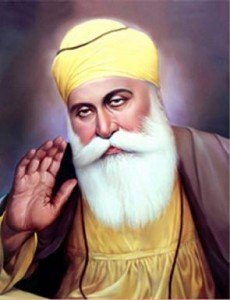 |
The link between Guru Nanak's divine AARTI, Jagannath Puri, Rabindranath Tagore and World Anthem. (An insight by Bobby Sing) |

As a revolutionary Sufi saint, Guru Nanak’s extensive travels in and outside India called Udaasis have several enlightening events associated with them prominently mentioned in the history books. But still it’s quite amazing to admit that not many actually know about Guru Nanak’s visit to Jagannath Puri (Orissa) and his rendition of the divine AARTI there, a wonderfully composed poetic explanation of the universe, that is now sung in every Gurdwara as a daily religious ritual as per the Sikh code of conduct post the recitation of Rehraas Sahib in Raag Dhanashri.
 Here we might have many versions about Guru Nanak’s visit to the Jagannath Temple but one conclusion that can be easily drawn from them all is that the Guru did witness the prestigious Aarti being held inside the temple with the priests bringing in a big platter having many lighted lamps, incense, fruits, flowers, ornaments and more being offered to the deity along with musical beating of drums, bells, cymbals and continuing chanting of sacred mantras from the scriptures.
Here we might have many versions about Guru Nanak’s visit to the Jagannath Temple but one conclusion that can be easily drawn from them all is that the Guru did witness the prestigious Aarti being held inside the temple with the priests bringing in a big platter having many lighted lamps, incense, fruits, flowers, ornaments and more being offered to the deity along with musical beating of drums, bells, cymbals and continuing chanting of sacred mantras from the scriptures.  Coming to the 20th century remembering Gurudev Rabindranath Tagore, its said that once the veteran actor Balraj Sahni, who taught in Santiniketan in the late 1930’s, asked Rabindra Nath Tagore that,
Coming to the 20th century remembering Gurudev Rabindranath Tagore, its said that once the veteran actor Balraj Sahni, who taught in Santiniketan in the late 1930’s, asked Rabindra Nath Tagore that, For more such interesting articles on lesser known facts on Hindi Cinema, do try DID YOU KNOW Series by Bobby Sing available in both Book and E-book form.
For more such interesting articles on lesser known facts on Hindi Cinema, do try DID YOU KNOW Series by Bobby Sing available in both Book and E-book form.|
15 Apr 2015 /
Comments (
12 )
Prakash Bhatia
Hi Bobbyji,
Bobby Sing
Hi Prakash Ji,
Sudhanshu
Dear Bobby,
Bobby Sing
Dear Sudhanshu,
Prakash Bhatia
Hi Bobbyji,
Bobby Sing
Dear Prakash Ji,
Sharmila
Thanks for article. Would like to know the words of Oriya and Bengali versions of the song too.
Bobby Sing
My pleasure Sharmila.
BIBHAS KUMAR SRIVASTAV
बहà¥à¤¤ सà¥à¤‚दर लेख - मैं सोचता हूठइसे हिनà¥à¤¦à¥€ में अनà¥à¤µà¤¾à¤¦ कर डालूà¤à¥¤ वासà¥à¤¤à¤µ में इस विषय पर à¤à¤• अचà¥à¤›à¥€ किताब होनी चाहिठहिनà¥à¤¦à¥€ में। मैं जब à¤à¥€ हरमिंदर साहब जाता हूठतो वहाठसिरà¥à¤«à¤¼ दैवी शबद सà¥à¤¨à¤¤à¤¾ हूà¤à¥¤ आतà¥à¤®à¤¾ को तर कर जाता है। हिनà¥à¤¦à¥€ फिलà¥à¤® के संगीतकार लगता है संगीत तैयार करने के लिठशबद सà¥à¤¨à¤¨à¥‡ वहाठजरूर जाते होंगे।
Bobby Sing
Thanks for your kind words of praise Bibhas Sir.
Bobby Sing
Thanks a lot Ajay Ji.
Manroop
Dear Booby ji, It would be of great help.
Bobby Sing
Dear Manroop, However I couldnt get the comment posted with the reference of 'Ae Hari sundar'.
Manroop
My apologies Bobby Ji!! Read it in some other article where it said Rabindranath Tagore has translated 'Ae Hari Sundar'..sorry mixed up with your article. Regards, |
Search